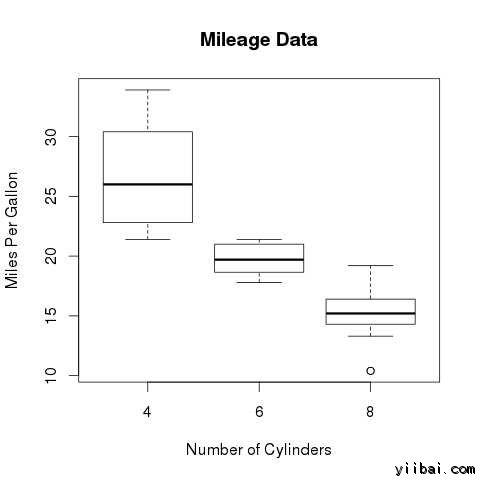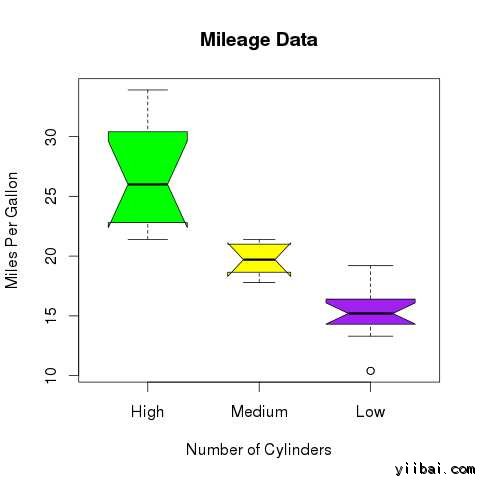R语言箱线图
发布于 2016-01-02 09:33:28 | 4610 次阅读 | 评论: 0 | 来源: 网络整理
箱线图是分布在一个数据集中的数据的量度。它把组分为三个四分位值的数据。此图表示的最小值,最大值,中值,第一个四分位数和第三个四分位数中的数据集。在通过拉伸箱图比较每个跨数据集数据的分布是有用的。
箱线图是通过使用 R 中的 boxplot()函数来创建。
语法
创建一个箱线图在 R 中的基本的语法是:
boxplot(x,data,notch,varwidth,names,main)
以下是所使用的参数的说明:
- x - 是一个向量或一个公式
- data - 是数据帧
- notch - 是一个逻辑值。设置为TRUE画一个缺口
- varwidth - 是一个逻辑值。设置为 true 时来画的宽度成正比到样本大小的方块。
- names - 是将每个箱线图下被打印的组标签。
- main - 用于给出曲线图的标题。
示例
我们使用数据集 “mtcars” 可在R环境中创建一个基本的箱线图。让我们来看看在 mtcars 的 "mpg" 和 "cyl" 列。
input <- mtcars[,c('mpg','cyl')]
print(head(input))
当我们上面的代码执行时,它产生以下结果:
mpg cyl
Mazda RX4 21.0 6
Mazda RX4 Wag 21.0 6
Datsun 710 22.8 4
Hornet 4 Drive 21.4 6
Hornet Sportabout 18.7 8
Valiant 18.1 6
创建箱线图
下面的脚本将创建 mpg(英里每加仑)和cyl(气缸数)之间的关系的一个箱线图。
# Give the chart file a name.
png(file = "boxplot.png")
# Plot the chart.
boxplot(mpg ~ cyl, data=mtcars,
xlab="Number of Cylinders",
ylab="Miles Per Gallon",
main="Mileage Data")
# Save the file.
dev.off()
当我们上面的代码执行时,它产生以下结果:

箱线图与缺口
我们可以得到箱线图与缺口,以了解如何不同类型数据的中位数相互匹配。
下面脚本将创建为每个数据组的箱线图与缺口。
# Give the chart file a name.
png(file = "boxplot_with_notch.png")
# Plot the chart.
boxplot(mpg ~ cyl, data=mtcars,
xlab="Number of Cylinders",
ylab="Miles Per Gallon",
main="Mileage Data",
notch=TRUE,
varwidth=TRUE,
col=c("green","yellow","purple"),
names=c("High","Medium","Low"))
# Save the file.
dev.off()
当我们上面的代码执行时,它产生以下结果:
